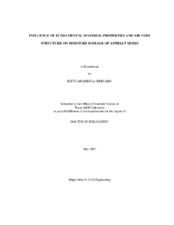| dc.description.abstract | Moisture damage in asphalt mixes refers to the loss of serviceability due to the presence of
moisture. The extent of moisture damage, also called moisture susceptibility, depends on internal
and external factors. The internal factors relate to the properties of the materials and the
microstructure distribution, while the external factors include the environmental conditions,
production and construction practices, pavement design, and traffic level.
The majority of the research on moisture damage is based on the hypothesis that
infiltration of surface water is the main source of moisture. Of the two other principal
mechanisms of water transport, permeation of water vapor and capillary rise of subsurface water,
the latter has been least explored. A laboratory test and analysis methods based on X-ray
computed tomography (CT) were established to assess the capillary rise of water. The amount
and size of air voids filled with water were used in the capillary rise equation to estimate the
distribution of the contact angles between the water and the mastic. The results were able to
show the influence of air void size on capillary rise and contact angles.
The relationship between air void structure and moisture susceptibility was evaluated
using a fundamental fracture model based on dissipated energy of viscoelastic materials.
Detailed description is provided in this dissertation on the deduction of the model equation, the
selection of the model parameters, and the required testing protocols. The model parameters
were obtained using mechanical tests and surface energy measurements. The microstructure of
asphalt mixes prepared in the laboratory having different air void structures was captured using
X-ray CT, and image analysis techniques were used to quantify the air void structure and air
void connectivity. The air void structure was found to influence the mix resistance to moisture
damage. To validate the fracture model, asphalt mixes with known field performance were tested.
The results demonstrated that the fracture model is an effective tool to characterize moisture
susceptibility. In addition, the model showed good correlation with the reported field
performance of the asphalt mixes.
The findings of this study will be useful to highway engineers to evaluate asphalt mixes
with alternative mix designs and internal air void structures and to estimate the rate of moisture
infiltration in order to maximize the resistance of asphalt mixes to moisture damage. | en |


